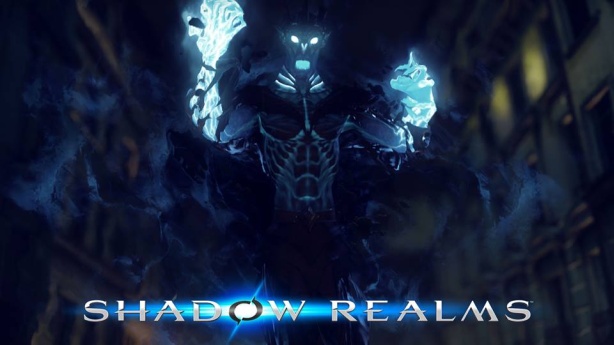
"We're focused on delivering the unexpected," Shadow Realms Senior Producer Dallas Dickinson said during a demonstration event at PAX Prime this weekend. After seeing the game in action, "unexpected" doesn't even begin to describe the chaos that will soon be unleashed by a developer rooted in deliberately paced single-player RPGs.
BioWare's Shadow Realms is a 4-versus-1 competitive multiplayer game that aims to capture the unpredictable nature of a dungeon master directing a tabletop game. The result is a deft mixture of Left 4 Dead and Tecmo's Deception series, challenging a party of players to navigate deadly dungeons overseen by a sadistic and omnipresent human opponent.
During each instanced quest in Shadow Realms, a team of four heroes attempt to navigate a trap-filled dungeon and slice their way through enemy mobs on their way to the area boss. A fifth player controls the Shadowlord, an invisible figure who can scout ahead of the party and lay traps accordingly.
Each mission has several walled-off areas where players fight AI-controlled creatures. The Shadowlord can direct these encounters to an extent by possessing any enemy creature within reach. Each possessed enemy type has its own attacks and abilities; melee-focused demons might have an area-wide attack that strikes multiple heroes within a large radius, while magic-wielding creatures can take advantage of their surroundings and snipe the party from behind nearby pillars.
Quests start all players off with only basic attacks and a single special ability. Upon reaching a checkpoint, a new ability is added to each player's arsenal. By the end of the quest, both heroes and the Shadowlord are formidable forces capable of dealing critical blows in a final series of high-stakes battles.

During my time with Shadow Realms, I played as the Shadowlord, and it didn't take long before the power I wielded transformed me into a colossal jerk. My favorite tactic involved racing ahead of the heroes, setting floor spike triggers where I thought they would tread, and then fire-bombing any adventurers unlucky enough to be impaled. These sorts of combo attacks are especially satisfying when you manage to snare more than one adventurer at a time – it's a treat to watch their health bars drain while their partners look on helplessly.
The Shadowlord's possession abilities come in handy during particularly busy enemy encounters. While the heroes are distracted by weak swarms of enemies, you might opt to become a doppelganger of a player character. When enemy attacks are coming from all angles, it might take a player several crucial seconds to realize that the "friend" fighting at his side is actually an evil clone stacking damage on top of enemy attacks.
By the time you get to each area's boss, your Shadowlord wields deadly powers. A room-filling boss presents a formidable challenge for the heroes, and the Shadowlord can possess the giant creature to focus its powerful attacks on a particular target. The demo's boss had an especially effective ability that constructed a temporary wall across the length of the arena, separating the heroes on either side. Players unfortunate enough to be on the boss's side of the wall can then be roasted by his scorching waves of fire breath while their friends are unable to assist.
Alternately, you might opt to summon and possess a lesser demon to fight alongside the boss, supplementing the AI's attacks with your own strikes. Distraction is a key tactic, and possessing even minor enemies can result in critical health drains for the heroic party during an extended boss battle.
The heroes eventually overpowered the boss during my playthrough, but I knocked out several players in the process, requiring their partners to dip into their limited supply of revival kits. Heroes receive very few kits at the mission's outset, earning more with each reached checkpoint. Playing as the Shadowlord requires the player to deliver fast, consecutive attacks to drain hero health as quickly as possible, forcing the party to run out of supplies before they face off against bosses.

The most interesting aspect of Shadow Realms' design is the way in which it makes players consider and exploit traditional game mechanics and expected player behavior as they progress through each level. As the Shadowlord, you essentially turn into a level designer, placing traps where they're most likely to be effective. At the same time, the heroic party is aware of your intentions, and may start to avoid or purposely trigger traps placed in obvious locations. It's a fascinating battle of wits that requires constant adaptation and shifts in strategy for either side to succeed.
Despite Shadow Realms' genre shift, fans of Mass Effect and Dragon Age will still find a lot to like. Shadow Realms retains the developer's traditional focus on player choice and customization. Players can create their heroes from scratch, customizing their race, gender, and other key traits while further tweaking their appearance and abilities with loot earned in battle. The choice wheel also returns, enabling players to leave their mark on the game's narrative.
Narrative is another area where Shadow Realms innovates. New episodic content will be released on a regular basis, and its overarching story is a particular point of focus. Mysteries will develop over the course of the series, and heroes will have to play through several episodes in order to see a resolution to lingering plotlines.
Senior Producer Dickinson likens the approach to the TV series Lost in structure, and hopes to foster the same sort of community discussion and "around the water cooler conversation" among fans. Previously released episodes will remain available after their debut as well, allowing players to "binge watch" several episodes at once to catch up on the storyline.
BioWare is currently seeking player feedback regarding Shadow Realms' combat mechanics during an early testing phase. A beta release is due in 2015.


